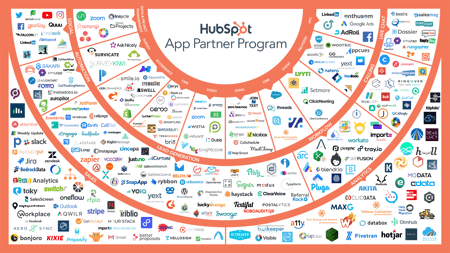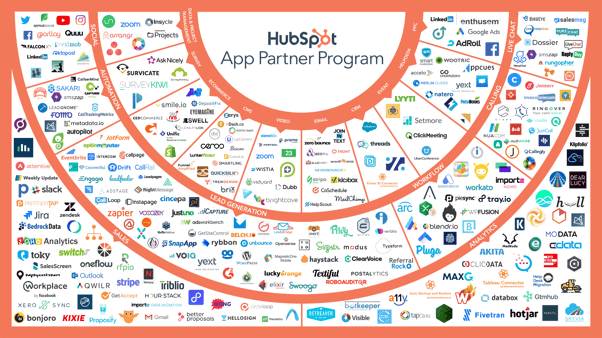How can you integrate HubSpot into your existing tech stack?

The HubSpot App Partner Program offers over 400 integrations with your existing tech stack. But how do you connect your existing tools with HubSpot to fully integrate your tech stack? In this blog, we'll explain this.
What integration options are available?
With your tools, you collect all kinds of data. Ideally, you want this data to be gathered in one central place. This way, you work most efficiently, gain the best insights, and can make the right optimizations. If you don't have all your data available in HubSpot yet but want to work more efficiently and gain better insights, then integrating with HubSpot is the solution.
There are 3 types of HubSpot integrations, namely:
- Native integration
A native integration is a standard integration that can be found in the HubSpot Partner Program (see image below). This is an integration developed by HubSpot itself and can be configured with the click of a button. - Custom integration
When you want an integration between a specific software that is not found in the HubSpot ecosystem, custom development is required. In that case, an API (Application Programming Interface) is used. With an API, you can still integrate the desired tool with HubSpot. This is possible because HubSpot offers an open API. You can find more information about this in the HubSpot Developer environment. - Integration via an integrator
The final option is to perform an integration through an integrator, such as Zapier or Tray.io. An integrator is a system that enables various systems to be connected (or integrated) with each other.
Example: You've been storing your deal registrations in Teamleader for years, but now you're using HubSpot for marketing activities. To ensure that you also have access to the deal data in HubSpot, an integration is needed. This way, you can effectively track the ROI of your marketing activities without having to switch between systems all the time.
How does an integration work?
When setting up one or more integrations with HubSpot, it's advisable to involve a HubSpot partner. For custom integrations, you generally need the expertise of a HubSpot partner to establish the connection properly. A native integration, meaning a standard integration from the HubSpot system, can be straightforward. However, there are also integrations that require more experience. In summary, we recommend collaborating with a HubSpot partner for integrations
Before starting an integration, we conduct an inventory to understand your integration requirements. We determine which data needs to flow from system X to HubSpot and whether it's a one-way or two-way sync. In other words, will the data only go to HubSpot, or should it also be sent back and updated? This analysis and mapping process is called field mapping. If the field mapping is approved, we proceed with building the integration (if it's custom). Then, we move on to a testing and development phase. Finally, we deploy the integration live. The integration will continue to be developed and updated regularly.
Keeping multiple integrations organized
In the case of large companies and multinationals, multiple integrations are often set up to link all systems together. In such cases, a common question arises: "How do I keep all these systems well organized?"
The most important tip: use one central system as the primary source of truth! We ourselves use HubSpot as the primary system. So when something is modified (such as customer data), everyone updates it in HubSpot by default. Through integrations, these changes are then automatically reflected in other systems, such as Teamleader.
The Operations Hub
Previously, PieSync was widely used for many integrations. PieSync facilitated data syncing between two or more systems. In November 2019, PieSync was acquired by HubSpot. HubSpot is utilizing the Operations Hub, which replaced PieSync. The Operations Hub aims to make it even easier to achieve certain integrations.
Getting started with HubSpot integrations!
Ready to dive into HubSpot integrations? Avoid common pitfalls and enlist the help of a HubSpot partner. We've already implemented various integrations with Exact, Teamleader, Microsoft Dynamics, and more!
We're here to assist you every step of the way. Contact our HubSpot Consultants today!


